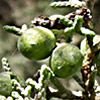Juniperus phoenicea (Phoenician Juniper) is an evergreen coniferous tree from the cypress (Cupressaceae) family. It can reach a height of 8 meters and an age of hundreds of years. Trees aged 850 have been observed in the northern Sinai. The branches are erect, the general structure is broad hut upright. The leaves are scaly, bluish, with a scarious margin. Their tip is rounded. The name “red” (in the Hebrew name) was apparently given because of the fruit (the cone), which is brown-reddish, or perhaps also because of the reddish bark.
Phoenician Juniper blooms in March and in April. It is pollinated by wind. The tree is monoecious. The cone is berry-like, small, spherical (with a diameter of 1 cm). It does not open, is fleshy, brown to reddish.
The global distribution of Phoenician Juniper spreads over most of the countries around the Mediterranean Sea, in particular Crete and the Greek islands, as well the Canary Islands. Phoenician Juniper is common in Edom and in the northern Sinai and south of the Mediterranean shores in the northern Sahara Desert. Some hypothesize that its existence in the desert is a relic from a time when a more humid climate existed in these regions, during the Ice Age. For some reason, it is absolutely missing from western Israel.
Use of Phoenician Juniper for construction was discovered in ancient sites in the Negev. These trees probably originated in the Sinai or in Edom. About half of all the trees used for construction at Masada are junipers, apparently from Edom. Juniper trees were also found among the trees used for heating at the copper mines of Timna.
The genus contains 60 species, which grow mainly in arid habitats in the temperate regions of the Northern Hemisphere, on both sides of the Atlantic Ocean. Many have adapted to borderline conditions: they grow in high mountains or plains and in non-extreme deserts. Many of the species are, accordingly, low, and many have a convoluted and picturesque trunk. Others are erect and grow in a conoid shape (or like a “Christmas tree”). Many species are common in ornamental gardens, where some spread out and are used to cover the ground. Four species of juniper grow in Israel and its environs.
Most of the species are dioecious (separate male trees and female trees). They are pollinated by wind, and the male trees produce a plentitude of pollen. In an individual of Juniperus excelsa on Mount Hermon the cones ripen, even though the closest male tree grows at a distance of more than 2 kilometers away. The female cone is fleshy and does not open upon drying, contrary to the cypress. The cone is spherical, usually small, with a diameter of 5-15 mm. It is colorful, dispersed by birds. It is not clear how it opens in nature to release the seeds. The leaves of some of the coniferous trees are prickly, short and divaricate, with a length of 2 cm. In other species they are scaly, tiny, imbricate as in the cypress. The two types of leaves sometimes appear on the same tree, or sometimes the germinating leaves are prickly, and the leaves on the mature tree are scaly.
The trees give off a pleasant fragrance, which is familiar in carpentry, and is also used as a perfume in industry in the production of gin, for seasoning meat and for scenting soap. In natural medicine the juniper is attributed great value for diverse uses. In carpentry it is commonly used for the design of furniture and ornamental objects. Juniper oil is used in laboratories as immersion oil for the microscope.
Written by Mike Livne




